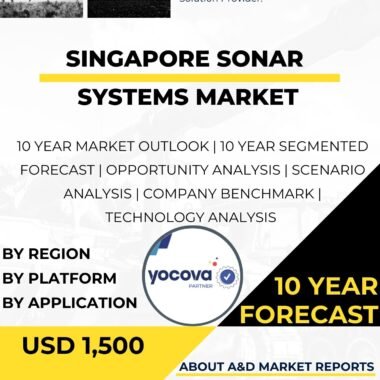Description
Malaysia Sonar Systems market has experienced significant advancement in recent years, reflecting the nation’s commitment to strengthening maritime security, enhancing naval readiness, and improving underwater detection capabilities. Sonar systems, which are sophisticated acoustic technologies used to detect, locate, and track underwater objects and movements, form a critical component of Malaysia’s maritime defense architecture. By adopting modern sonar solutions, Malaysia is building a more resilient, responsive, and technologically advanced maritime security network that supports national sovereignty and safeguards strategic waters.
Maritime Security Needs Driving the Malaysia Sonar Systems Market
Malaysia’s geographical position, vast coastline, and extensive maritime zone in Southeast Asia expose the country to various maritime security challenges. These include illegal fishing, smuggling, piracy, territorial incursions, and the emergence of modern submarine threats. The Sonar Systems market in Malaysia is growing due to the increasing need for reliable underwater surveillance tools capable of monitoring, detecting, and responding to these threats effectively. Sonar technologies enable the country to maintain vigilant oversight of its coastal areas, protect marine resources, and ensure the security of vital sea lanes that support economic activity.
Technological Advancements in the Malaysia Sonar Systems Market
The Sonar Systems market in Malaysia has benefited from major technological breakthroughs. Modern sonar platforms now utilize advanced transducers, superior signal processing techniques, and sophisticated data fusion methods that significantly enhance detection range, sensitivity, and classification accuracy. These improvements have broadened the operational capabilities of sonar systems, making them indispensable for underwater monitoring, reconnaissance, and maritime surveillance missions. As a result, Malaysia now has better tools to track underwater disturbances, detect submerged threats, and support a variety of naval and security operations.
Defense Integration in the Malaysia Sonar Systems Market
The Royal Malaysian Navy plays a crucial role in driving demand within the Sonar Systems market in Malaysia. Naval surface ships and submarines are equipped with sonar systems that allow them to conduct anti-submarine warfare, identify underwater hazards, and track potential threats. These systems empower naval forces to maintain situational awareness, support coastal defense operations, and respond swiftly to emerging challenges in Malaysia’s maritime zones. As Malaysia continues to modernize its naval fleet and upgrade underwater defense capabilities, sonar technologies remain essential to ensuring operational effectiveness across both shallow and deep-water environments.
Industry Development and Local Participation
The Sonar Systems market in Malaysia is also shaped by the country’s growing ambition to strengthen its defense industrial base. The Malaysian government has shown increasing interest in promoting local research, manufacturing, and innovation in sonar technologies. Through collaborations with global defense companies, Malaysia is gaining access to advanced system designs, engineering expertise, and technology transfer opportunities. These initiatives support domestic talent development, enable indigenous capability growth, and contribute to the long-term goal of reducing reliance on foreign sonar suppliers.
International Collaboration Supporting the Sonar Systems Market in Malaysia
Malaysia’s pursuit of advanced underwater detection capabilities has encouraged strategic collaborations with international defense partners. Through global procurement programs, co-development projects, and joint R&D initiatives, Malaysia has enhanced its access to the latest sonar systems, improved workforce expertise, and strengthened its position within the international sonar technology landscape. Such partnerships continue to play an important role in upgrading Malaysia’s maritime surveillance capabilities and ensuring that its naval forces remain aligned with modern global defense standards.
Challenges Facing the Sonar Systems Market in Malaysia
Despite its positive trajectory, the Sonar Systems market in Malaysia encounters several challenges. One of the most significant obstacles is the high cost associated with acquiring, operating, and maintaining advanced sonar systems. These technologies require substantial financial commitments for research, procurement, training, and logistical support. Additionally, the effective operation of sonar systems depends heavily on skilled personnel, necessitating continuous training programs within the Royal Malaysian Navy to ensure accurate interpretation of underwater acoustic data. Environmental challenges—including underwater noise pollution caused by marine activities—can also interfere with sonar performance, making it essential for Malaysia to conduct environmental assessments and adopt noise mitigation measures to maintain system reliability.
Future Outlook
The Sonar Systems market in Malaysia is positioned for sustained growth, supported by the government’s emphasis on strengthening maritime security and investing in advanced underwater detection technologies. As sonar systems continue to evolve with improved performance, automation, and integration capabilities, they are likely to play an increasingly important role in Malaysia’s defense strategy. Malaysia’s participation in regional maritime security initiatives, joint naval exercises, and multilateral defense collaborations will further shape future sonar acquisition and modernization requirements, particularly regarding interoperability with allied forces and regional partners.
Conclusion
In conclusion, the Sonar Systems market in Malaysia has progressed significantly, driven by the country’s focus on maritime security enhancement, naval modernization, and technological investment. The integration of modern sonar systems into naval platforms, combined with international partnerships and emerging local innovation, has strengthened Malaysia’s underwater surveillance and defense capabilities. Nevertheless, long-term success will depend on addressing challenges related to budget constraints, technology development, environmental factors, and the availability of skilled personnel. By continuing to prioritize advanced sonar technologies and maritime defense infrastructure, Malaysia can further enhance its ability to secure territorial waters, protect maritime assets, and maintain a robust security posture across its maritime domain.




